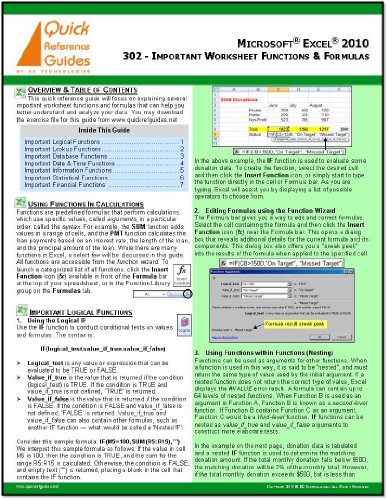MICROSOFT EXCEL 2010 Quick Reference Guide: Important Worksheet Functions & Formulas (302)
This post contains affiliate links. As an Amazon Associate I earn from qualifying purchases 8-page bifold quick reference guide, one of several quick reference guides for Excel 2010. This quick reference guide is a comprehensive reference to important functions and formulas in Excel. While there are over 200 functions in Excel, in this guide you
This post contains affiliate links. As an Amazon Associate I earn from qualifying purchases
8-page bifold quick reference guide, one of several quick reference guides for Excel 2010.
This quick reference guide is a comprehensive reference to important functions and formulas in Excel. While there are over 200 functions in Excel, in this guide you will learn how to use and apply a select few that are critical to becoming proficient in data analysis and calculations with functions.
The guide will help you learn how to use formulas in different categories. For example, you will create logical functions using IF, nested IF, AND, OR. Then you will create lookup functions such as VLOOKUP, ROWS, COLUMNS, MATCH. Then you will create database functions such as DSUM, DAVERAGE, DMIN, DMAX. Then you will create text functions such as LEFT, RIGHT, MID, TRIM, CONCATENATE. Then you will create date/time functions using NOW, DATE, TIME, DAY, MONTH, YEAR, EDATE. Then you will create information functions using NA, ISBLANK, ISERROR. Then you will create mathematical and statistical functions such as SUMIF, ROUND, MOD, INT, COMBIN, MIN, MAX, MODE, STDEV, AVDEV. Finally you will learn about useful financial functions such as PMT, FV, RATE, NPER. We will also discuss how to create custom functions using simple Visual Basic commands.
Product Features
- Part of a series of several quick reference guides for Excel 2010, each focusing on a set of specific and important topics such as Excel 2010-201, Excel 2010-202, Excel 2010-203, Excel 2010-204, Excel 2010-301, Excel 2010-302, Excel 2010-303, Excel 2010-304, Excel 2010-401, Excel 2010-402 and much more.
- Learn how to create and apply functions in various categories.
- Apply formulas to enhance complex calculations and data analysis.
- Create your own functions using simple VBA code.
- Formulas are a must in almost any worksheet. Being comfortable with formulas and being able to create them will give you an edge and allow you to expand your horizons so that you do more with your data.
This post contains affiliate links. As an Amazon Associate I earn from qualifying purchases








